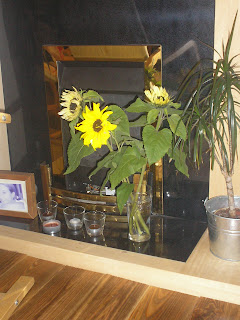Although I haven't been posting much in March, I have been out on the plot pretty much every weekend, dodging snow and hail showers ! Hopefully the cold unsettled weather is behing us now and we can finally look forward to spring "proper".
But before I thought I'd post a bumper update of the various jobs I have been doing on the plot in March.
- Early this month, I finally did some tidying up in the strawberry bed - removed all the runners that escaped my attention at the end of the summer, pulled the weeds and cleared dead leaves and debris. I also decided to cover the whole bed with black fabric; this will keep the bed weed free and also will prevent the fruit from rotting down on the soil. I also moved the bushes that were at the back of this bed and transplanted some of last year runners. So that's me hoping for a bumper harvest of strawberries this year !!!

Before and after pictures of the strawberry bed . I have a row each of Mara des Bois and Elsanta bought from Ken Muir last year and the rest are an unknown variety, kindly donated by my neighbour.
- I finally dug up the remaining of the Jerusalem Artichokes. In the pictures below are a couple of plants worth; I planted about 10, which was enough for us to have a meal of Jerusalem Artichokes pretty much every week from October till March - pretty good, I think. As an experiment I blanched and froze the last harvest - I'm not sure if JA freeze well, I guess we'll see! I also saved 14 of the best tubers, which I replanted straight away. Two weeks on, they're not showing yet, but I didn't really expect them to anyway!


Top row: Red Onion - Baron and bottom row: Shallot - Jermor
- I transplanted the fig, orange and lemon trees from Lidl in big pots, wrapped them in a lot of horticultural fleece and left them outside. And yes, I know, this was a big silly gamble.
The results are rather mixed so far. The orange and lemon trees are doing great but the fig trees are clearly a lot more fragile and lost their leaves to some pretty heavy frost. I have now rescued them and brought them back inside where they seem to be recuperating well. I have spotted a few buds already and I'm pretty confident they will make a full recovery. Fingers crossed !

- On Good Friday I planted potatoes.
- A couple of weeks ago, I sowed some peas, 40 each of Kelvedon Wonder, Early Onward, Norli (mange tout) and Sugar Bon (sugar snap). Our clay soil was still a bit too cold to sow direct, they are in modules in a cold frame. No show so far but it's been so cold, I can't blame them!
- Today I also sowed some broad beans. And to contradict myself, they went in direct! But I have a pretty good reason for that; last year, the mice ate all the broad beans in the cold frame but didn't touch the peas - I know, funny mice ... But they also didn't touch the broad beans when they were planted direct. I do not try to understand how Glaswegian mice work. I just learn from past casualties!
- I also did a few tidying up jobs around the beds, building and rebuilding path and bed borders. But as it started hailing when I was finishing I didn't hang around to take pictures! You'll have to wait to judge my bricklaying skills!
And finally, the usual view from the top of the plot taken this afternoon in between two hail showers.



 Clockwise from top left corner:
Clockwise from top left corner: 
 Fruit tree extravaganza - Fig, orange, lemon and fig again (and potatoes chitting away)
Fruit tree extravaganza - Fig, orange, lemon and fig again (and potatoes chitting away)






















 My small greenhouse, standing proud in March 07
My small greenhouse, standing proud in March 07







